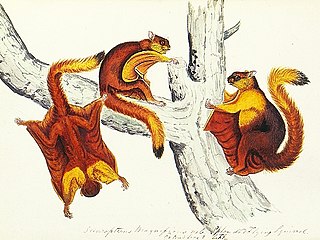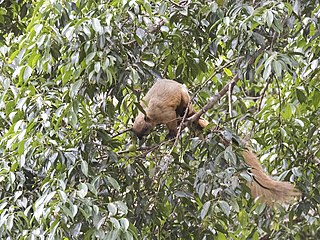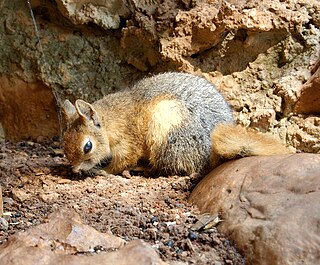
The Douglas squirrel is a pine squirrel found in western North America, from the Pacific Northwest to central California, with an isolated subspecies in northern Baja California, Mexico. It is sometimes known as the chickaree or pine squirrel, although these names are also used for the American red squirrel. Variant spellings of the common name are Douglas' squirrel and Douglas's squirrel. The Native Americans of Kings River called it the "Pillillooeet", in imitation of its characteristic alarm call.

The grizzled giant squirrel is a large tree squirrel in the genus Ratufa found in the highlands of the Central and Uva provinces of Sri Lanka, and in patches of riparian forest along the Kaveri River and in the hill forests of Karnataka, Tamil Nadu and Kerala states of southern India. The International Union for Conservation of Nature (IUCN) lists the species as near threatened due to habitat loss and hunting.

The Indian giant squirrel or Malabar giant squirrel is a large multi-coloured tree squirrel species endemic to forests and woodlands in India. It is a diurnal, arboreal, and mainly herbivorous squirrel.

The southern Amazon red squirrel, is a squirrel species from South America where it inhabits forests in much of north-western South America east of the Andes. Three subspecies are currently recognised. It is a dark red colour, or a dark brown grizzled with ochre, has whitish underparts and grows to a total length of 48 to 63 cm, including a very long tail. It spends much of its time on the ground in the undergrowth and feeds largely on nuts. Little is known of its breeding habits, but it is a sociable species, several individuals often feeding together in one tree. This squirrel faces no particular threats, has a wide range and is relatively common, and the International Union for Conservation of Nature lists it as a "least-concern species".

The Amazon dwarf squirrel is a chipmunk-sized tree squirrel native to South America.

The Neotropical pygmy squirrel is a South American species of tree squirrel, being the only living species in the genus Sciurillus and the subfamily Sciurillinae. Genetic analysis has shown it to be the sister group to all other squirrels.

The red giant flying squirrel or common giant flying squirrel is a species of rodent in the family Sciuridae (squirrels). It is found in a wide variety of forest–types, plantations and more open habitats with scattered trees in Southeast Asia, ranging north to the Himalayas and southern and central China. One of the largest arboreal squirrels, all populations have at least some reddish-brown above and pale underparts, but otherwise there are significant geographic variations in the colours. The taxonomic position of those in the Sundaic region is generally agreed upon, but there is considerable uncertainty about the others, which variously have been included in this or other species, or recognized as their own species.
The Kinabalu squirrel is a species of rodent in the family Sciuridae. It is endemic to highland forest in East Malaysia. Its name is a reference to Mount Kinabalu, though it is not restricted to this mountain. Its tail and upperparts are grizzled blackish, the underparts are reddish-orange, and the flanks have a narrow buff stripe with a broader black stripe below.

The grey-bellied squirrel is a species of rodent in the family Sciuridae. It is found in forests, plantations and gardens in Peninsular Malaysia, Thailand, southern Myanmar, southern China (Yunnan) and possibly western Laos. It has been introduced in the Ryukyu Islands in Japan. As suggested by its name, its belly is usually grey, though sometimes reddish on the sides. Depending on subspecies and season, the upperparts are grey, yellowish-olive or reddish.

Finlayson's squirrel or the variable squirrel is a species of rodent in the family Sciuridae. It is found in Cambodia, Laos, Myanmar, Thailand, and Vietnam. The species occurs in a wide range of wooded habitats, including gardens and parks in cities like Bangkok. It was named in honour of the Scottish naturalist and traveller George Finlayson.

Prevost's squirrel or Asian tri-coloured squirrel is a colourful species of rodent in the family Sciuridae. It is found in forests in the Thai-Malay Peninsula, Sumatra, Borneo and nearby smaller islands, with an introduced population in northern Sulawesi. Although the Prevost's squirrel is declining in some regions because of habitat loss and hunting, the species is not considered threatened since it generally remains common and widespread. It can live in somewhat disturbed habitats and often visits plantations or gardens. It mostly feeds on plant material, especially fruits, but also takes insects.

Alexander's bush squirrel is a species of squirrel native to the Democratic Republic of the Congo and Uganda. It is arboreal and lives in tropical moist forests, especially undisturbed mature forests. It is a common species with a wide range, and the International Union for Conservation of Nature has rated it as being of "least concern". Its common name and Latin binomial commemorate Lieutenant Boyd Alexander, a British Army officer, explorer and ornithologist.

The red and white giant flying squirrel is a species of rodent in the family Sciuridae. It is a very large, dark rufous-red, buff and white flying squirrel found in forests at altitudes of 800–3,500 m (2,600–11,500 ft) in mainland China and 1,200–3,750 m (3,940–12,300 ft) in Taiwan, although the population of the latter island is distinctive and likely better regarded as a separate species, the Taiwan giant flying squirrel. Additionally, the red and white giant flying squirrel possibly ranges into northeastern South Asia and far northern Mainland Southeast Asia. This squirrel has a wide range and is relatively common, and the International Union for Conservation of Nature lists it as being of "least concern".

The spotted giant flying squirrel, also known as the lesser giant flying squirrel, is a species of rodent in the family Sciuridae. It is found in hill and mountain forests at altitudes of 200–4,000 m (660–13,120 ft) in Southeast Asia north to central China and the east Himalayan region, although the northern populations sometimes are regarded as separate species as the grey-headed giant flying squirrel, Chindwin giant flying squirrel and P. marica. Two of these, as well as a few other populations, lack the white spots on the upperparts for which it is named. Although a large flying squirrel, it is a relatively small giant flying squirrel.

Hodgson's giant flying squirrel is a species of rodent in the family Sciuridae. This large flying squirrel lives in Himalayan forests in Asia. Like other flying squirrels, it is nocturnal and able to glide long distances between trees by spreading out its patagium, skin between its limbs.

The Bhutan giant flying squirrel, also known as the Gray's giant flying squirrel or noble giant flying squirrel, is a species of rodent in the family Sciuridae. This species lives in Himalayan forests and it is one of the largest flying squirrels. Like other flying squirrels, it is mainly nocturnal and able to glide long distances between trees by spreading out its patagium, skin between its limbs.

The Indian giant flying squirrel, also called the large brown flying squirrel or the common giant flying squirrel, is a species of rodent in the family Sciuridae. It is capable of gliding flight using a skin membrane, the patagium, stretched between front and hind legs. It is found in mainland Southeast and South Asia, and southern and central China.

The forest giant squirrel or Stanger's squirrel is a species of rodent in the family Sciuridae found in Angola, Benin, Burundi, Cameroon, the Central African Republic, the Republic of the Congo, the Democratic Republic of the Congo, Ivory Coast, Equatorial Guinea, Gabon, Ghana, Kenya, Liberia, Nigeria, Rwanda, Sierra Leone, Tanzania, Togo, and Uganda. Its natural habitats are subtropical or tropical moist lowland forests and plantations.

The cream-coloured giant squirrel or pale giant squirrel is a large tree squirrel in the genus Ratufa found in forests in the Thai-Malay Peninsula, Sumatra (Indonesia), Borneo and nearby small islands. The species is near threatened and vulnerable to habitat degradation, and it has probably been extirpated in Singapore where the last sighting was in 1995. Reported sightings in Vietnam in 1984 are considered to be dubious.

The Caucasian squirrel or Persian squirrel, is a tree squirrel in the genus Sciurus found in temperate broadleaf and mixed forests in south-western Asia.
























